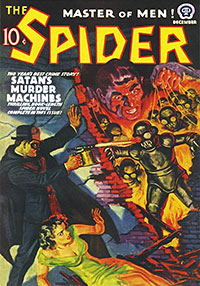
Back in 1996, I was thrilled to hear about a new book called “The Great Pulp Heroes,” by Don Hutchison.
I bought my first copy on July 30, 1996. (The receipt is still tucked away in the back of the book.) I say first copy, because when the book was re-released in 2007, I bought a second copy.
I enjoyed reading the book and discovering a number of pulp heroes that, at the time, I was unfamiliar with. I still turn to the book every so often to look up a fact or to refresh my memory on a character.
[box type=”shadow”]
3 Pulp Questions
3 Pulp Questions is an opportunity for you to get to know fellow pulp collectors a bit better and, maybe, introduce you to pulps, authors, stories or characters that you haven’t explored.[/box]
In addition to “The Great Pulp Heroes,” Don has edited a number of anthologies with fiction from pulp magazines such as Dime Detective, Detective Tales, The Mysterious Wu Fang, Thrilling Adventures and Complete Northwest Magazine: “The Super Feds: A Facsimile Selection of Dynamic G-Man Stories from the 1930s” (1988); “It’s Raining Corpses in Chinatown” (1991); “Scarlet Riders: Pulp Fiction Tales of the Mounties” (1998); and “It’s Raining More Corpses in Chinatown” (2001).
He’s also edited five volumes of Canadian horror stories titled “Northern Frights,” and a best-of collection titled “Wild Things Live There.”
In 1990, he was given the Lamont Award at Pulpcon 19.
I’m excited that Don is the next up on our series called “3 pulp questions”:
1. How were you introduced to the pulps?
 2. What is your most prized pulp possession?
2. What is your most prized pulp possession?
3. What overlooked (pulp magazine, story, author, character, or series) would you recommend to pulp fans and why?


This is a great series, Bill. And it’s always good to see Don Hutchinson. I remember buying THE GREAT PULP HEROES many years ago when I was learning about my grandfather’s career.
Hi, Laurie. Glad you’re enjoying the series. More to come!
Yes, “The Great Pulp Heroes” is a terrific book. Highly recommended for anyone who doesn’t have it.
Don and I have been friends since the early years of Pulpcon in the seventies. I always look forward to seeing him every year at Pulpfest. THE SPIDER is one of the few hero pulps that I have any respect for and I agree with Don that it is fun to read. He is absolutely right about the adventure or general fiction pulps. They have been overlooked and deserve to talked about. The best stories I’ve read have often come from such magazines as ADVENTURE, SHORT STORIES, ALL STORY, BLUEBOOK and ARGOSY.
Yeah, the best stuff is mostly in the mags Martin mentioned. The Super Hero stuff made up less than 5% of sales during the hey day of the pulps.
I’m just surprised that it took until 1996 for someone to publish a book called THE GREAT PULP HEROES. Up to that point, we had already had THE GREAT COMIC BOOK HEROES (Jules Feiffer, 1965), THE GREAT RADIO HEROES (Jim Harmon, 1967), and THE GREAT MOVIE SERIALS (Harmon and Don Glut, 1972). Ron Goulart also came out with his book about pulp heroes in 1972, but for some reason he (or the publisher) goofed and called it CHEAP THRILLS.
Well, it was a long wait between 1972 and the next major survey of pulp heroes, but at least Don Hutchison got the title right this time! Seriously, a great book and my go-to guide along with Goulart (almost have them both committed to memory by now) until the recent publication of Ed Hulse’s THE BLOOD ‘N’ THUNDER GUIDE TO PULP FICTION. Of them all though, Hutchison’s love of the characters really shines through.
As far as widely distributed books go, you’re correct. (And, yes, “Cheap Thrills” isn’t a very title; cute, yes, but it could apply to any topic.)
But during the 1980s, Robert Sampson wrote quite a few books on the pulp heroes, both the more popular ones as well as the lesser known ones. They were published by the Popular Press at Bowling Green State University (at the time). You weren’t going to find those at your neighborhood bookstore. I had to special order them.
Once I stumbled onto The Shadow doubles from Doubleday’s Crime Club series in the early ’80s, I made it a habit of regularly combing through the Books In Print volumes at the bookstore or library for pulp-related books. I knew pulp books weren’t going to show up on the shelves.
That’s how I ended up discovering (and ordering) The Shadow doubles, “The Shadow Scrapbook,” “The Duende History of The Shadow,” and all of Sampson’s books.
So in the 1990s, I was thrilled to discover “The Great Pulp Heroes” on the shelf at the bookstore.